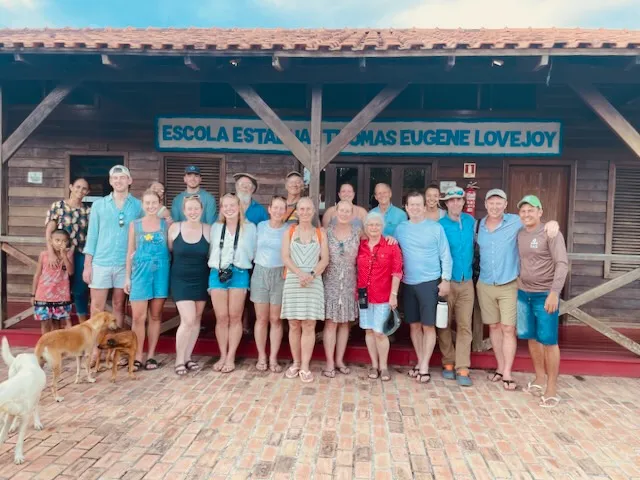Comments from Tom Lovejoy about the Amazon rainforest wildfires
Media reports have been full of reports about Amazon fires. There was so much smoke Monday afternoon August 19 in São Paulo the street lights went on three hours early. This is certainly one of the greatest fire years in the Brazilian Amazon (sadly Bolivia also) of all time. The previous record was probably 1987, a very dry year because of El Niño, which produced a smoke cloud as big as Brazil hanging over South America. I remember taking off from Brasilia with the then two Texas senators: the plane entered a grey-brown cloud (which was all former Amazon forest), then a normal white cloud before breaking out into the blue.

Before these 2019 fires, the Brazilian government was in denial about deforestation figures produced by the Brazilian space agency INPE (which is world class, known for the excellence of its scientific work). Even with the fires the government's first reaction was to accuse the NGOs of setting them - which simply doesn't compute. But Brazilian public concern was so great, and global alarm so instant that President Macron put the matter on the agenda for the G-7 and threatened to block ratification of the European community agreement with Mercosur. In reaction President Bolsonaro addressed the nation and said he was sending the army to deal with the problem. That was insufficient to settle public concern and citizens went to the streets banging pots and pans - a traditional way of showing displeasure. I have been peppered with media requests and have endeavored to accept as many as possible. One of the most recent is a request for an essay by Brazil's largest circulation print publication, VEJA, in which I will endeavor to lay out a path forward. The solution without question will require international collaboration because the problem is simply too big. In addition there are eight other Amazon countries. Even together they have insufficient technical and other resources, so it will need developed countries as well. And there is a historical successful precedent. In 1990, the G-7 meeting in Houston discussed the situation of the Brazilian Rain Forests and created the G-7 Program for the Brazilian Rain Forests managed by the World Bank. It was a demonstrable success. Additional technical and financial success built on that: Norway's billion dollar Amazon fund which Bolsonaro has been trying to cripple. The Amazon Region Protected Area Program (in two parts ARPA-1 and ARPA-2). And of course Brazil hosted the Earth Summit in 1992 and Rio + 20 in 2012. The Bolsonaro government has turned its back on this Brazilian "brand" as an international environmental leader. The Amazon Biodiversity Center 's field sites are safe. Happily. But what has been and will be its role? Our hundreds of graduates have been part of the expertise on which media has drawn, and of course they are all trained problem solvers. They are in the end one of the best guarantees for a sustainable future of the Amazon because they have learned about it firsthand. Their accumulated work give people like me the credibility to recommend solutions many of which will be theirs. So we have a start to a better future for the Amazon than would have seemed possible last Monday. The hard work begins. -- Dr. Thomas Lovejoy, August 24, 2019




![[VIDEO] Exploring what's left of Brazil's Amazon rainforest](https://static.wixstatic.com/media/16e93b_a00b695c67a3449fa185d6adddea96e0~mv2.jpg/v1/fill/w_220,h_123,fp_0.50_0.50,q_90,enc_auto/16e93b_a00b695c67a3449fa185d6adddea96e0~mv2.jpg)








![[ARTICLE] Preserving forests is an essential climate solution...yet we are failing](https://static.wixstatic.com/media/16e93b_2186718cb00d4b999bef3c650ad61015~mv2.jpg/v1/fill/w_38,h_25,fp_0.50_0.50,q_90,enc_auto/16e93b_2186718cb00d4b999bef3c650ad61015~mv2.jpg)

![[VIDEO] Learn More About the Amazon Rainforest's Native Bird Species](https://static.wixstatic.com/media/16e93b_3f2044e90ead4ef193a66fd3efd09f28~mv2.jpg/v1/fill/w_38,h_21,fp_0.50_0.50,q_90,enc_auto/16e93b_3f2044e90ead4ef193a66fd3efd09f28~mv2.jpg)

![[FUNDRAISER] Help Amazon Rainforest Field Assistants Impacted by COVID-19](https://static.wixstatic.com/media/16e93b_a90b4dc9be8149a0b6d947f8b069be8b~mv2.jpg/v1/fill/w_38,h_68,fp_0.50_0.50,q_90,enc_auto/16e93b_a90b4dc9be8149a0b6d947f8b069be8b~mv2.jpg)


![[ARTICLES] Dr. Lovejoy on the future of the Amazon rainforest](https://static.wixstatic.com/media/b5a942_c99239719cb14099bdfab987c9574ee0~mv2.jpg/v1/fill/w_38,h_25,fp_0.50_0.50,q_90,enc_auto/b5a942_c99239719cb14099bdfab987c9574ee0~mv2.jpg)
![[VIDEO] The Amazon Rainforest’s Tipping Point](https://static.wixstatic.com/media/16e93b_125e784f3d514837b53b67df591a5dea~mv2.gif)

